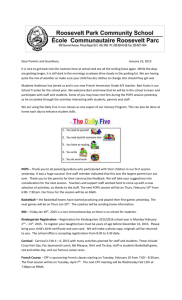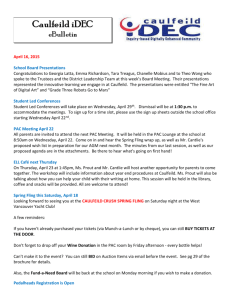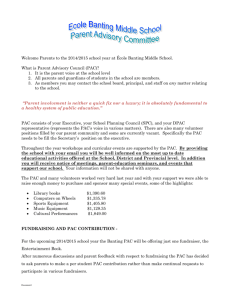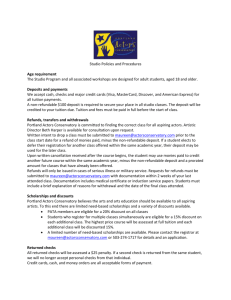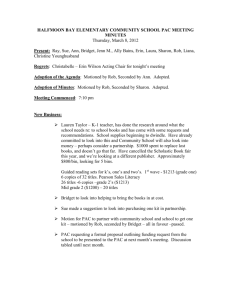emi412091-sup-0002-si
advertisement
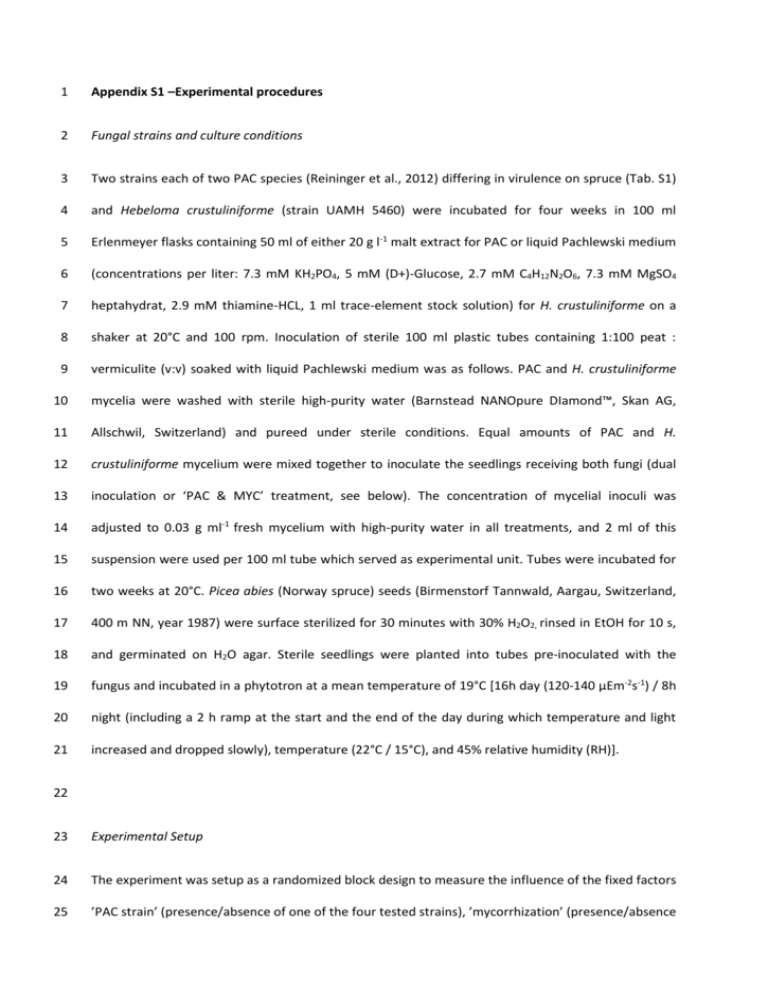
1 Appendix S1 –Experimental procedures 2 Fungal strains and culture conditions 3 Two strains each of two PAC species (Reininger et al., 2012) differing in virulence on spruce (Tab. S1) 4 and Hebeloma crustuliniforme (strain UAMH 5460) were incubated for four weeks in 100 ml 5 Erlenmeyer flasks containing 50 ml of either 20 g l-1 malt extract for PAC or liquid Pachlewski medium 6 (concentrations per liter: 7.3 mM KH2PO4, 5 mM (D+)-Glucose, 2.7 mM C4H12N2O6, 7.3 mM MgSO4 7 heptahydrat, 2.9 mM thiamine-HCL, 1 ml trace-element stock solution) for H. crustuliniforme on a 8 shaker at 20°C and 100 rpm. Inoculation of sterile 100 ml plastic tubes containing 1:100 peat : 9 vermiculite (v:v) soaked with liquid Pachlewski medium was as follows. PAC and H. crustuliniforme 10 mycelia were washed with sterile high-purity water (Barnstead NANOpure DIamond™, Skan AG, 11 Allschwil, Switzerland) and pureed under sterile conditions. Equal amounts of PAC and H. 12 crustuliniforme mycelium were mixed together to inoculate the seedlings receiving both fungi (dual 13 inoculation or ‘PAC & MYC’ treatment, see below). The concentration of mycelial inoculi was 14 adjusted to 0.03 g ml-1 fresh mycelium with high-purity water in all treatments, and 2 ml of this 15 suspension were used per 100 ml tube which served as experimental unit. Tubes were incubated for 16 two weeks at 20°C. Picea abies (Norway spruce) seeds (Birmenstorf Tannwald, Aargau, Switzerland, 17 400 m NN, year 1987) were surface sterilized for 30 minutes with 30% H2O2, rinsed in EtOH for 10 s, 18 and germinated on H2O agar. Sterile seedlings were planted into tubes pre-inoculated with the 19 fungus and incubated in a phytotron at a mean temperature of 19°C [16h day (120-140 µEm-2s-1) / 8h 20 night (including a 2 h ramp at the start and the end of the day during which temperature and light 21 increased and dropped slowly), temperature (22°C / 15°C), and 45% relative humidity (RH)]. 22 23 Experimental Setup 24 The experiment was setup as a randomized block design to measure the influence of the fixed factors 25 ’PAC strain’ (presence/absence of one of the four tested strains), ’mycorrhization’ (presence/absence 26 of mycorrhiza) and ‘block’ (to account for the heterogeneity in the phytotron two blocks including 27 five replicates per treatment) on plant and PAC biomass, the degree of mycorrhization and the 28 root/shoot ratio (response variables). Eight experimental units (replicates) received the same 29 treatment (factor combination) and each of the two blocks comprised four replicates per treatment. 30 The experiment run for 7 months in the phytotron after planting the seedlings. Plants were watered 31 three times a week with deionized water as needed. Once a month each tube was fertilized with an 32 equal amount (4-6 ml depending on the experimental stage) of a 1-4 ml l-1 WUXAL solution [1.4 to 5.6 33 mM phosphate] (Universaldünger, Maag, Syngenta Agro AG, Dielsdorf, Switzerland). 34 35 Sampling and data collection 36 Roots of all eight replicates per treatment were carefully washed under running tap water to remove 37 the peat-vermiculite. Seedlings inoculated with H. crustuliniforme were placed into large glass Petri 38 dishes filled with insipid tap water to investigate the degree of mycorrhization under the binocular 39 using the following classification system: 0 = no mycorrhization, 1 = 1-25% of the root tips 40 mycorrhized, 2 = 26-50%, 3 = 51-75%, and 4 = 76-100%. 41 Seedlings were cut into roots and shoot, dried at 50°C for 48 hours and weighed. Prior to drying, root 42 segments were cut from three plants (replicates) per treatment for further analysis. Seven 5-mm- 43 long segments were randomly excised from each of three main roots of each of these three plants 44 for DNA extraction, and one additional segment per main root was used for reisolation. For DNA 45 extraction, the segments from each plant, i.e. 21 root segments, were pooled, freeze dried and 46 weighed. To estimate PAC colonization density ([g] PAC mycelium per [g] root dry weight), 3 mg of 47 freeze-dried reference mycelium was added before DNA extraction (mycelium of strain C was added 48 as reference to root samples containing strain A, mycelium of strain A to root samples containing 49 strains B, C and D; for details see Reininger et al. (2011)) and stored at -80°C until further processing. 50 The three root segments for PAC reisolation resulting from each seedling were surface-sterilized in 51 30% H2O2 for 30 s and 10 s in EtOH and incubated on terramycin-malt agar (20 g l-1 malt extract, 15 g 52 l-1 agar, 50 mg l-1 terramycin®) at room temperature. 53 54 DNA extraction, microsatellite PCR and microsatellite fragment analysis 55 Frozen root-reference-mixtures were homogenized in 2 ml safe-lock tubes, using a Retsch machine 56 MM 200, adding a small metal ball and a few grains of sand. DNA extraction followed the 57 manufacturers protocol of the DNeasy plant mini kit (Qiagen, Hilden, Germany) except for the lysis 58 buffer which was replaced by hexadecyltrimethylammonium bromide (CTAB) according to Rogers et 59 al. (1989) and Rogers and Bendich (1994). Microsatellite PCR was performed in 15 µl volumes 60 containing 2 µl 1:40 diluted DNA, 50 mM KCl, 10 mM Tris-HCl, 1,5 mM MgCl2, 200 µM dNTPs 61 (Amersham Pharmacia Biotech), 0,4 µM of each primer and 0,3 U Taq polymerase (Amersham 62 Pharmacia Biotech). The running conditions were 2 min at 94°C followed by 33 cycles of denaturation 63 for 30 s at 94°C, annealing for 30 s at 53°C and extension for 30 s at 72°C (followed by a final 64 extension step of 10 min at 72°C) (Queloz et al., 2008). For the microsatellite fragment analysis 15- 65 fold diluted amplicons of the PCRs were prepared and 4 µL of the dilutions were mixed with 9.05 µL 66 Hi-DiTM formamide and 0.25 µL GeneScanTM 500 LIZTM (Applied Biosystems). Fragment lengths and 67 the area under the light emission curve (AUC) of each fragment were measured using an ABI 3730xl 68 DNA Analyzer (Applied Biosystems) and analyzed using the GeneMapper v. 4.0 software (Applied 69 Biosystems) (Queloz et al., 2010). Biomass of PAC mycelia in and on roots was estimated using the 70 method described in Reininger et al. (2011). 71 72 Statistical analysis 73 All statistical analyses were done with the statistical software R (R Development Core Team, 2010). 74 Due to very high correlation of root and shoot biomass (data not shown), analyses were done with 75 total plant biomass except for the root/shoot ratio analysis. Six seedlings had to be excluded from 76 data analysis since mycorrhization failed. ANOVA models [1]-[4] including interactions between 77 factors were examined (µ = overall mean): 78 79 Plant biomass = µ + PAC strain + mycorrhization + block [1] 80 Root/shoot ratio = µ + PAC strain + mycorrhization + block [2] 81 PAC biomass = µ + PAC strain + mycorrhization + block [3] 82 Degree of mycorrhization = µ + PAC strain + block [4] 83 84 Reductions of the full models [1]-[3] were sought using the ‘stepAIC’ (Akaike Information Criterion) 85 function implemented in ‘R’. The factor ’mycorrhization’ in models [1]-[3] is binary with 1 = H. 86 crustuliniforme added and 0 = no H. crustuliniforme added. Letters above the bars in bar charts were 87 calculated with the function ‘pairwise.t.test’ to find significant differences between treatments. 88 Correlation between plant dry weight and endophytic PAC biomass amount were examined for 89 plants inoculated with PAC only (single inoculation) and for dual inoculated plants with PAC and H. 90 crustuliniforme using linear regression. Best transformations of the models were sought comparing 91 residual analyses (Tukey-Anscombe plot, Q-Q plot, leverage plot). 92 93 94 95 96 97 98 99 100 101 102 103 104 References Queloz, V., Duo, A., and Grünig, C.R. (2008) Isolation and characterization of microsatellite markers for the tree-root endophytes Phialocephala subalpina and Phialocephala fortinii s.s. Mol Ecol Resour 8: 1322-1325. Queloz, V., Duo, A., Sieber, T.N., and Grünig, C.R. (2010) Microsatellite size homoplasies and null alleles do not affect species diagnosis and population genetic analysis in a fungal species complex. Mol Ecol Resour 10: 348-367. R Development Core Team (2010) R: A language and environment for statistical computing. Vienna, Austria: R Foundation for Statistical Computing. Reininger, V., Grünig, C.R., and Sieber, T.N. (2011) Microsatellite-based quantification method to estimate biomass of endophytic Phialocephala species in strain mixtures. Microb Ecol 61: 676-683. 105 106 107 108 109 110 111 112 113 Reininger, V., Grünig, C.R., and Sieber, T.N. (2012) Host species and strain combination determine growth reduction of spruce and birch seedlings colonized by root-associated dark septate endophytes. Environ Microbiol 14: 1064-1076. Rogers, S.O., and Bendich, A.J. (1994) Extraction of total cellular DNA from plants, algae and fungi. Plant Molecular Biology Manual (SB Gelvin & RA Schilperoot, eds). Rogers, S.O., Rehner, S., Bledsoe, C., Mueller, G.J., and Ammirati, J.F. (1989) Extraction of DNA from Basidiomycetes for Ribosomal DNA Hybridizations. Can J Bot 67: 1235-1243.


